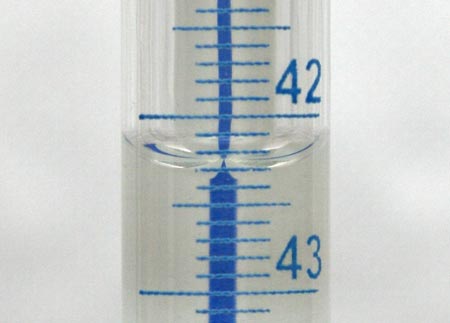Identify the oxidising agent in this reaction:
Zn(s) + Cu²⁺(aq) → Zn²⁺(aq) + Cu(s)
Cu2+
Write the equilibrium constant expression for
2NO2(g) ⇌ N2O4(g)
K=[N2O4]/[NO2]2
Identify the semi-structural formula of propan-2-ol.
CH₃CH(OH)CH₃
What is the term for the point in a titration at which the indicator changes color?
End point
Explain the difference between repeatability and reproducability.
Repeatability = same conditions, same person
Reproducibility = different conditions/person/lab
Write the balanced equation for photosynthesis.
6CO2 + 6H2O → C6H12O + 6O2
Explain why increasing temperature increase the rate of reaction?
Because particles have more kinetic energy, leading to more frequent collisions with sufficient energy. This increases the proportion of successful collisions
Identify the products of a reaction between ethanol and butanoic acid.
Ethyl butanoate and water
A molecule contains the structural feature: ...CH–CH2...
Identify the splitting pattern of the peaks featured somewhere in its 1H NMR spectrum?
a doublet AND a triplet
To how many decimal places should the volume be measured in this burette? 
2 decimal places
E.g. 42.31 mL
In terms of bond energy, what happens during an endothermic reaction?
More energy is required to break the bonds of the reactants than is released when new bonds are formed in the products.
Write the overall equation for the electrolysis of molten NaCl.
2NaCl(l) --> Na(l) + Cl2(g)
Identify the reactants required to synthesise a primary amine from a haloalkane.
Primary haloalkane and ammonia (NH3).
How many unique carbon environment in pentan-2-one?
A student measures a temperature as 23.4°C, 23.5°C, and 23.5°C. The actual temperature is 25.0°C. Comment on the accuracy and precision.
The results are precise but not accurate.
What volume of CO2 (at SLC) is produced from burning 1.55 mol of methane completely?
CH4 + 2O2 --> CO2 + 2H2O
1:1 mole ratio
V= n x Vm = 1.55 x 24.8
V(CO2) = 38.4 L (3 SF)
Explain the difference between rate and extent of a reaction.
Rate is how fast a reaction occurs; extent is how much product forms once equilibrium is reached.
Identify the type of reaction used to produce biodiesel from plant oil.
Transesterification - reaction of triglycerides with an alcohol
Explain the main difference between simple and fractional distillation.
Simple distillation uses a condenser and flasks to separate liquids with large boiling point differences (greater than 25°C), while fractional distillation uses a column to separate liquids with a small boiling point differences.
Ensure results accurately reflect the variable being tested (lack of uncontrolled variables)
Ensure experimental method is appropriate for answering the aim/research question.
Minimise systematic errors that could distort results.
Ensures conclusions are logically supported by the data collected.
Explain how the use of hydrogen fuel cells supports one green chemistry principles compared to traditional combustion engines.
Designing for energy efficiency - use of energy rich hydrogen gas with minimal negative environmental impact due to H2O byproduct (unlike harmful CO2 byproduct in combustion engine).
Atom economy - a hydrogen fuel cell has a much better atom economy because it converts H2 and O2 directly into H2O. A combustion engine is less efficient as it burns fuel, wasting a significant amount of energy as heat.
Prevention of waste - no waste in H fuel cell
Use of renewable feedstock - H fuel cell can use renewable energy source
Identify and explain what will happen if K>Q for a system?
The system will favour the forward reaction to form more products until equilibrium is reached.
There are too many reactants and not enough products, and the forward reaction will consume reactants to increase the product concentration until Q=K and equilibrium is reached again.
Compare the boiling point of pentanol and pentanoic acid. Explain the difference.
Pentanoic acid would have a higher boiling point than pentanol. This is due to its ability to form strong hydrogen-bonded dimers between the COOH groups.
Explain what happens to an enzyme when it is heated beyond its optimal temperature.
The enzyme undergoes denaturation, causing its 3D shape to be irreversibly altered. This change prevents the substrate from binding to the active site to catalyse a reaction.
During an acid-base titration, a student records a burette reading of a acid of known concentration as 24.10 mL when it should be 24.00 mL. Identify the type of error and the effect on the end point.
Systematic error
The student has overestimated the volume of acid, so the calculated concentration of the base will appear higher than it actually is (the end point is recorded as reached too early).